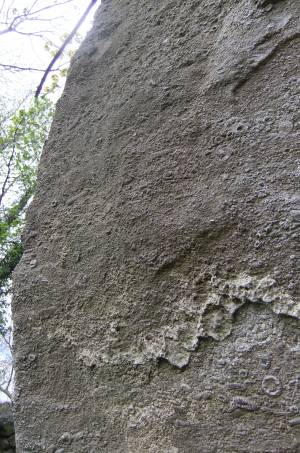|
| *****SWAAG_ID***** | 498 |
| Date Entered | 16/04/2012 |
| Updated on | 16/04/2012 |
| Recorded by | Tim Laurie |
| Category | Geological Record |
| Record Type | Geological HER |
| Site Access | Public Footpath |
| Record Date | 15/04/2012 |
| Location | Lower Wensleydale |
| Civil Parish | Preston Under Scar |
| Brit. National Grid | Hidden |
| Altitude | 200 |
| Geology | Middle Limestone |
| Record Name | Middle Limestone with massed crinoid remains |
| Record Description | Kelheads Quarry – Crinoidal limestone
Kelheads Quarry was one of nine small quarries run by Leyburn R.D.C. to provide roadstone. Around 1890 the council found it too expensive to buy roadstone from the local commercial quarries and so began to open up small local quarries. Keldheads is small by modern standards with a working face of 50-60 metres. The maximum height of the face is approximately 10 metres.
The quarry was cut into a crinoidal limestone that shows excellent specimens of crinoid stems. This is the Middle Limestone of the Yoredale Cyclothems-and it lies just to the west of the north-south Keld Heads fault system.
The quarry face is packed with the disarticulated stem remains of sea lilies (not a good name as they are invertebrates belonging to the subphylum Crinozoa). The crinoids are related to echinoderms and starfish, which have a five rayed or pentameral symmetry. The sea lilies have a calcite skeleton which has greatly contributed to the development of many Palaeozoic limestones. The crinoids have a fully marine origin because they are stenohaline, making the Middle Limestone a marine limestone.
The body of the crinoid consists of a stem, calyx and moveable arms which originate from the margin of the calyx. The stem is flexible and sometimes several metres in length. It is the stem that survives, while the more delicate calyx and arms break up on death. The majority of crinoids were stalked and attached to the substrate by a root.
The most common carboniferous crinoids are Actinocrinus, Amphocrinus, Poteriocrinus, Platycrinus, Rhodocrinus and Woodocrinus, but to identify these, the calyx must be present. Most Palaeozoic genera became extinct during the Permo-Triassic mass extinction. Other marine fossils like Productus, found in the quarry, confirm the marine nature of the Middle Limestone.
John Russell 16th April 2012
|
| Dimensions | Substantial. |
| Additional Notes | Important NOTE!
Hammering of exposed rock surfaces to remove specimens of fossils is not permitted at all locations.
It is nearly always possible to get good photographs and specimens may be collected from from river gravels. |
| Image 1 ID | 2640 Click image to enlarge |
| Image 1 Description | Massed crinoid remains. Middle limestone. |  |
| Image 2 ID | 2641 Click image to enlarge |
| Image 2 Description | The exposed cliff. |  |
| Image 3 ID | 2642 Click image to enlarge |
| Image 3 Description | |  |
| Image 4 ID | 2643 Click image to enlarge |
| Image 4 Description | |  |
| Image 5 ID | 2644 Click image to enlarge |
| Image 5 Description | |  |
| Image 6 ID | 2645 Click image to enlarge |
| Image 6 Description | |  |
| Image 7 ID | 2646 Click image to enlarge |
| Image 7 Description | |  |